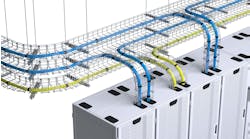Microsoft Nuclear PPA to Restart Three Mile Island Shows Hyperscalers' Urgency for Clean Energy
In a year that began with AWS making similar news in the same state for similar reasons, here at the end of September, the announcement of Microsoft signing a power purchase agreement (PPA) with Constellation in Pennsylvania jump-starts the creation of the Crane Clean Energy Center, and that's not all: The centerpiece of the project is the restart of the Three Mile Island Nuclear Station Unit 1 in Pennsylvania which, when restored to service, will be able to add over 800 megawatts (MW) of carbon-free energy to the grid.
This will go a long way toward supporting Microsoft’s hyperscale decarbonization goals. The project's stated intent is to have the nuclear plant online by 2028. At this point in time, the plant is not slated to support a specific data center, but rather to offset other Microsoft energy consumption.
Hyperscalers Race Toward Clean Energy
In January 2024, Microsoft hired Archie Manoharan as director of nuclear technologies, a long time executive in the nuclear power industry, who had most recently worked with a start-up focusing on micro reactor technologies. Prior to that she had, among other roles, put in four years with the Tennesee Valley Authority, which operates three large reactor campuses as part of their energy generation infrastructure. Erin Henderson was also hired, directly from the TVA, as head of nuclear development acceleration.
For its part, in the last few weeks, Amazon has been aggressively pursuing its own hire of a nuclear energy specialist, posting a job for Principal Nuclear Engineer, Datacenter Engineering, Power Generation Solutions. The position is very directly focused on bringing AWS into the nuclear fold, with the key job responsibilities listed as:
- Influence key external partners such as OEMs and developers to design operationally efficient and safe modular nuclear plants and associated balance of plant delivering carbon free capacity to AWS's growing business.
- Build internal and external nuclear product and fuel strategy roadmaps, influencing clean energy strategy for AWS data centers.
- Evaluate and deliver carbon free power generation solutions by working with internal and external global partners.
- Drive due-diligence on specific power projects and recommendations to senior leadership on specific power solutions that meet AWS’s needs.
- Build relationships with senior leaders and other stakeholders in energy, power and utilities companies, regulatory bodies and the Department of Energy (DOE).
And while Google hasn’t made any public statements about hires in this role, they recently announced partnering with Microsoft and Nucor in development efforts for nuclear power.
Turning the Power Back On
Microsoft's agreement with Constellation is bringing the efforts of hyperscalers in the nuclear world to another level.
Getting a nuclear generating station back online – particularly for plants that have been offline for a long time, such as the Three Mile Island (TMI) Unit 1, in Pennsylvania and Palisades, in Michigan – presents a set of challenges, from technical and economic issues to regulatory and social considerations.
As the US looks to maintain energy security while decarbonizing the electric grid, restarting long-shuttered nuclear plants has captured renewed attention. Earlier this year, the DOE announced that it would fund the restart of the Palisades Nuclear Power Plant through a new infrastructure revitalization program that flags nuclear energy as a source of clean, baseload power.
Examination
We will now be looking at the main technical, regulatory, financial, environmental and social challenges related to the possible restart of nuclear generating stations such as TMI Unit 1 and Palisades.
We should be optimistic that these plants will ultimately restart, because restarting these nuclear generating stations could lead to a significant reduction in greenhouse emissions by providing an almost-zero-carbon powered energy source to the electric grid.
And getting this carbon-free baseload power to the grid is absolutely crucial to successfully meet decarbonization goals while growing the availability of power.
Technical Challenges
There are no few technological barriers to bringing this technology back on-line. This is to be expected as both plants were built over 50 years ago; TMI Unit 1 began operations in 1974, and Palisades in 1971.
Aging Infrastructure and Technological Upgrades
Problem number one is that the existing infrastructure at both TMI Unit 1 and Palisades exists in a decayed state. 50-year-old equipment inevitably ages, especially when its purpose is to accommodate the enormous stresses of electricity generation through nuclear fission.
Most of the components that comprise these nuclear power stations have either completed or otherwise exceeded their originally designed lifespans. And even supposing these plants have been kept in mothballs or a state of readiness, there are formidable technical issues to be considered when upgrading equipment to state-of-the-art safety and operating standards.
Elephant In Room
Let’s first address the elephant in the room: the partial meltdown of Unit 2 at the Three Mile Island nuclear plant in 1979.
The investigation into the partial meltdown concluded it was caused by a combination of equipment failure and human error. The accident led to a small amount of radioactive gas being released, but health studies found that it was not enough to cause adverse health effects.
Reactor Types
Both reactors at the TMI site are the same type and manufacturer; Pressurized Water Reactors (PWR), designed and built by Babcock & Wilcox (B&W).
With updates to the control systems and control room, Unit 1 continued to operate successfully until 2016, when it was shut down for economic reasons. At that point in time the reactor had been previously relicensed by the NRC to run until 2034.
Palisades, also a PWR, though from a design from a different vendor, was decommissioned in 2022, and had been permanently shut down in 2019, and would face the same technology challenges. Restarting the reactor would require replacing many parts and systems that were designed decades before cutting-edge nuclear technology advanced significantly. For example, today’s reactors use digital control systems and very advanced safety systems that were not available when TMI Unit 1 and Palisades were conceived.
Extensive refurbishing, upgrading and testing would be required before Palisades could operate an additional 25 years in accordance with new requirements for reliability and customer safety that result from both existing prevailing plant performance and changing grid demands, as well as compliance with requirements expected to be incorporated into plant licensing.
Safety Considerations
There will be significant consideration of safety issues in the restarting of these plants.
These plants can then be restarted only after they are evaluated to ensure that all of their safety-related components, such as containment systems, emergency core cooling systems, and radiation monitoring equipment, have been inspected, upgraded, and tested.
The plant’s owner and operator will need to demonstrate to the NRC that their detailed information about the plant, the availability of replacement parts, and the adequacy of their workforce’s training meet the NRC’s requirements for safe operation.
For Palisades, these regulatory issues are handled under the guidance of the Palisades Restart Panel (PRP), which is a special panel created by the NRC to direct the regulatory delivery of its documents and information about nuclear power safety.
It can only be presumed that a similar panel will be created to guide and monitor the restart of TMI.
Spent Fuel Management and Waste Storage
Dealing with the spent fuel and waste management issues of any nuclear generating station is an issue, and the Palisades plant boasts a long history of proliferation issues stemming from spent nuclear fuel.
The clean-up from the TMI Unit 2 accident is well documented. Any re-opening of these plants would create more nuclear waste, which needs to be stored safely in place or at a long-term storage facility.
The Palisades plant, particularly, has raised the most speculation about potential storage problems, at least if the plant returns to operation and continues to run for another two decades.
Spent fuel management remains one of the most controversial issues in the nuclear industry, from both a technical and a social perspective.
Regulatory and Policy Challenges
With the restarting of decommissioned nuclear power plants being a new concept, both to the NRC and society in the US, there will be a litany of issues that need to be addressed from the regulatory and policy perspectives.
Nuclear Regulatory Commission (NRC) Licensing
To restart TMI Unit 1 and Palisades will take the operators through a regulatory thicket.
Any decommissioned or decommissioning nuclear plant must apply for a new operating license from the NRC. This requires Application Review Board hearings and reviews.
The review is often lengthy as the NRC must assure itself that the decommissioned plant can be brought back into operation compliant with present-day agency regulations, far stricter than those pertaining when the plant originally commenced operation.
For Palisades, the NRC has established the Palisades Restart Panel, whose mission is to inform on those unique, but crucial, regulatory issues surrounding restart of a decommissioned plant.
The restart process will entail technical and safety reviews, public hearings, and engagement with local communities and stakeholders, all of which will enable public validation of safety of the plant and the adequacy of its NRC oversight given the broader societal sentiments regarding nuclear energy.
This process comes at a time when there has been pressure to simplify the procedures necessary to get NRC approval for new nuclear power, due primarily to the interest in SMR, microreactor, and fusion-based power plants.
Energy Infrastructure Reinvestment and Federal Support
The federal government’s interest in the production of “clean” power is one reason it sees the restart of nuclear facilities as part of its decarbonization effort.
"Restarting Palisades will prevent emissions equivalent to those produced by nearly one million gas-powered cars each year," according to a recent DOE announcement.
The DOE’s 2022 $250 billion Energy Infrastructure Reinvestment program is accepting applications for grant money to revitalize or replace existing energy infrastructure.
However, federal support is no guarantee of unlocking regulatory obstacles.
Even with these expressions of federal support, it does not mean that the plant operators don’t have to go through a renewed licensing process (20 years for TMI Unit 1), which would require years and substantial investment with no guarantee of a plant that can be restored to economic viability.
Financial Viability and Economic Challenges
While it seems that hyperscalers in the data center industry are willing to roll the dice on the chance of a positive outcome in getting previously shut down nuclear power generation back online, and the grid can certainly use the additional carbon-free power, we are looking at a significant investment of time and money with no guarantee of a return, for several reasons as listed here.
High Cost of Restarting Nuclear Plants: A Gamble?
Bringing a nuclear power plant back to life is a costly endeavor. The DOE has allocated $1.5 billion for revitalizing and refurbishing the Palisades plant, a price tag that includes necessary repairs, upgrades to the long-term safety systems, as well as the battery of tests that must be conducted before the plant can begin operating again safely for another 20 to 25 years.
Not all nuclear plants will benefit from this level of federal investment, and it’s not clear whether restart technology can be applied to the half-lives of plants such as TMI Unit 1, which seem so old and have been out of service for so long.
Reactor operators will have to buy new and highly expensive equipment, upgrade safety standards, adhere to more modern regulatory norms, and prepare for increased insurance premiums as well as new liabilities for potential future disasters or accidents.
In short, this process will be a major gamble, and needs to be compared to the cost of investment in new, advanced reactor technologies, as well as additional development such a natural gas generation plants, and renewables such as sun and wind.
Market Dynamics and Competing Energy Sources
Which brings us to the second problem, other energy options.
For many plants, economics has been the decisive motivation for shutting down a nuclear plant – not technical or safety issues.
For instance, in the case of Palisades, its owner, Consumers Energy, was incentivized to shut down and replace the plant with gas.
In a market where low-cost gas and low-cost wind and solar are gaining momentum, nuclear energy’s base-load plants might not make economic sense without substantial financial incentives or regulatory support.
Or if the investors are looking at the cost from the perspective of hyperscale data center operators needing to power the massive growth in AI-focused facilities. The power demands of AI may well restructure the entire energy generation model worldwide.
Nuclear energy is still one of the most mature clean energy technologies available for producing the baseload power to meet near-term energy needs with near-term carbon reductions.
Nevertheless, even with the demands of hyperscale data centers and AI, government policy and market interventions might be necessary to ensure that nuclear plants remain economically viable in a new and more competitive energy landscape.
Environmental and Social Impacts and Benefits
While the benefits of nuclear power to clean energy and climate change concerns can be clearly documented, addressing the societal issues -- necessary to prevent NIMBY protests and to garner acceptance of the realities of nuclear power as a clean, renewable power source -- is a non-trivial matter.
Restarting TMI Unit 1 and Palisades in particular would have significant environmental benefits relative to fossil fuels; the electricity from Palisades, a zero-emission energy source, displaces fossil‑fuel generation.
Any power plant that operates 24 hours a day is automatically a stable baseload source of power; the next-best alternatives for baseload (coal or natural gas) are not zero-emission.
The DOE estimates that the restart of Palisades will prevent emissions equivalent to those produced by almost one million gas-powered cars every year.
Public Perception and Community Concerns
Even if they were perfectly effective, the environmental benefits would be overshadowed by public attitudes to nuclear energy that, as demonstrated by the situations at TMI Unit 2 in 1979 and Fukushima in Japan more recently, remain a problem.
Decommissioning guarantees that restarting a plant with such a historic precedent could focus public opposition to nuclear power and an aversion to operating an old nuclear station.
In areas where local populations might be especially wary of nuclear energy, such as the residents who still remember the local impact of the TMI accident, community engagement will be needed more than ever.
A significant level of transparency of the planned safety features, operations, and specific concerns engendered by previous nuclear plant accidents will need to be addressed in ways the public can understand.
To put it bluntly, the NRC and the operators will have to provide a lot of public information about safety features and oversight.
So Where Does This Leave Us?
Reopening nuclear generating stations, such as TMI Unit 1 and Palisades, is going to be a gauntlet of technical, regulatory, financial and social hurdles.
If done correctly, there are clear environmental benefits to bringing these systems back online, especially in the context of reducing carbon emissions.
Raising a significant amount of clean energy capacity in the US will require substantial investments to avoid repeating mistakes.
Fortunately, the initiative by the DOE to fund the restart of Palisades via its Energy Infrastructure Reinvestment program signifies a promising beginning.
Success will require sustained government support, tight regulatory oversight, and community engagement.
But it could easily set a precedent for adapting and reinvigorating other dormant nuclear plants throughout the country, thus advancing clean energy goals and ensuring a reliably low-carbon source of electricity on the grid.
Pennsylvania-based CBS 21 News reports on the local ramifications of the announced 20-year power purchase agreement between Microsoft and Baltimore-based company Constellation Energy Corporation.






